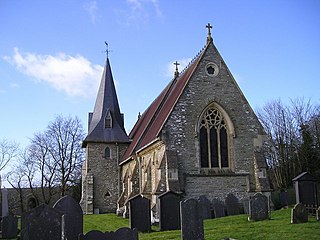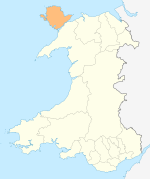Salomon was a late 5th century Cornish 'warrior prince', possibly a King of Cornwall. His feast day takes place on the 18 October. He was the father of the Cornish bishop Saint Cybi.

Saint Cynllo is a British saint, who lived in the late 5th and early 6th centuries, generally described as a brother of Saint Teilo. Cynllo was known for "...the sanctity of his life and the austerity of his manners."

Llanafan Fawr is a village and community and ecclesiastical parish in Powys, Wales. Located in the former cantref of Buellt (Builth) and historic county of Brecknockshire, the community includes the former parish of Llanfihangel Bryn Pabuan.

Llanllowell is a village in Monmouthshire, southeast Wales, in the United Kingdom. It is two miles southeast of Usk, in the community of Llantrisant Fawr.

Saint Afan of Builth was an early 6th-century Welsh bishop, martyr, and saint. His feast day is generally placed on 17 November, although the Demetian Calendar formerly used in southern Wales placed it on the 16th; it is no longer observed by either the Anglican or Catholic church in Wales.
Llan and its variants are a common element of Celtic placenames in the British Isles and Brittany, especially of Welsh toponymy. In Welsh the name of a local saint or a geomorphological description follows the Llan morpheme to form a single word: for example Llanfair is the parish or settlement around the church of St. Mair. Goidelic toponyms end in -lann.
Ieuan is one of several Welsh forms of the male given name John.
Saint Cwyllog was a Christian holy woman who was active in Anglesey, Wales, in the early 6th century. The daughter, sister and niece of saints, she is said to have founded St Cwyllog's Church, Llangwyllog, in the middle of Anglesey, where a church is still dedicated to her.

The Old Church of St Afran, St Ieuan and St Sannan, Llantrisant, is a redundant church in the settlement of Llantrisant, Anglesey, Wales. It is designated by Cadw as a Grade II* listed building, and is under the care of the Friends of Friendless Churches. It is set in an isolated location off a country road and is adjacent to a farmstead.
Tyfrydog was a Christian from north-west Wales in the fifth or sixth century, who was later venerated as a saint. He is said to have established a church in Anglesey, and although no part of the original structure remains, the current church is still dedicated to him. A nearby standing stone is said to be the remains of a man who he punished for stealing a bible from the church.
Caffo was a sixth-century Christian in Anglesey, north Wales, who is venerated as a saint and martyr. The son of a king from northern Britain who took shelter in Anglesey, Caffo was a companion of St Cybi, and is mentioned as carrying a red-hot coal in his clothes to Cybi without his clothes getting burnt. After leaving Cybi, Caffo was killed by shepherds in the south of Anglesey, possibly acting in retaliation for insults Caffo's brother had paid to the local ruler. The area where he died has a village, Llangaffo, named after him, as well as the parish church of St Caffo, Llangaffo.

St Caian's Church, Tregaian, also known as St Caean's Church, Tregaean, is a small medieval church dating from the 14th century in Anglesey, north Wales. It is dedicated to St Caian, a Christian from the 5th or 6th century about whom little is known. The building contains a late 14th-century east window and a late 15th-century doorway. The churchyard contains the grave of William ap Howel, who died in 1581 at the age of 105, leaving over forty children between the ages of 8 and 89 and over three hundred living descendants.

St Llibio's Church, Llanllibio is a demolished church in Anglesey, north Wales. Founded by Llibio in the sixth century, the church served a small community of bondmen as a chapel of ease. The population of Llanllibio declined substantially during the Middle Ages as a result of the Black Death and changes in farming practice, amongst other factors, and the community that the church served effectively disappeared. As a result, St Llibio's closed in the seventeenth century; the remaining worshippers moved to another local church.

The Old Church of St Gwenllwyfo, Llanwenllwyfo is a medieval ruined church near Dulas, in Anglesey, Wales, perhaps built in the 15th century to replace another church from which only the 12th-century font survived. Dedicated to Gwenllwyfo, a 7th-century female saint about whom nothing else is known, it was used as a chapel of ease for the church in Amlwch, about 5 miles (8 km) away. Restored in 1610 and again in the 18th and 19th centuries, it contained an oak screen and pulpit from 1610.

St Edwen's Church, Llanedwen, is a 19th-century parish church near the Menai Strait, in Anglesey, north Wales. The first church was founded here by St. Edwen in 640, but the present structure dates from 1856 and was designed by Henry Kennedy, the architect of the Diocese of Bangor. It contains some memorials from the 17th and 18th centuries and a reading desk that reuses panel work from the 14th and 17th centuries. The 18th-century historian Henry Rowlands was vicar here, and is buried in the churchyard. The church is on land that forms part of the Plas Newydd estate, home of the family of the Marquess of Anglesey since 1812 and owned by the National Trust. Some of the Marquesses of Anglesey, and some of their employees, are also buried in the churchyard.

St Enghenedl's Church, Llanynghenedl, is a former parish church in Anglesey, north Wales, dedicated to the son of a 6th-century King of Powys. According to the 19th-century antiquarian Angharad Llwyd, the first church in Llanynghenedl was erected in about 620. A new church was erected in 1862, replacing a building that the 19th-century clergyman and antiquarian Harry Longueville Jones noted as dating in part from the late 13th or early 14th century, based on the decorations on the south doorway. The church later fell into disuse as a result of the growth of the nearby village of Valley and the church there. In 1988, St Enghenedl's was dismantled and re-erected as an extension to St Mihangel's, Llanfihangel yn Nhowyn, so that St Mihangel's could serve as the church for RAF Valley. The former churchyard of St Enghenedl's is still visible but is now overgrown.(The churchyard is being cared for and no longer overgrown 2020 update)

Saint Elli was a 6th-century Welsh saint, or possibly two saints. Llanelli, a town in Carmarthenshire and Llanelly, a village in the traditional county of Brecknockshire are both named after Elli.

Saint Eigrad or Eugrad was a sixth-century Welsh saint and the founder of St Eugrad's Church in Llaneugrad, Anglesey.

Saint Einion Frenin was a late 5th- and early 6th-century Welsh confessor and saint of the Celtic Church. His feast day was originally given as 9 February, although this had moved to the 10th or 12th by the 16th century and is no longer observed by either the Anglican or Catholic church in Wales.

Llanfechan is a small church settlement in the community of Treflys, consisting of a church and a farm, and the surrounding area, it is beside the A483 on the north side of the Irfon Valley near Cilmeri, about 7 kilometers (4.3 mi) west of Builth Wells, Powys, Wales.

![]() Welsh pronunciation ; Welsh for "Parish of the Three Saints") is a hamlet in Anglesey, Wales. It is in the community of Tref Alaw. [1]
Welsh pronunciation ; Welsh for "Parish of the Three Saints") is a hamlet in Anglesey, Wales. It is in the community of Tref Alaw. [1] 













